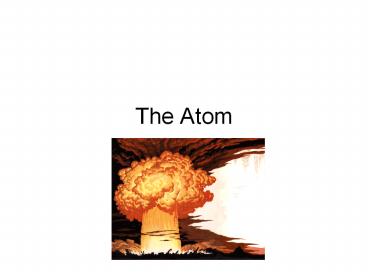The Atom PowerPoint PPT Presentation
1 / 19
Title: The Atom
1
The Atom
2
What is an Atom?
- Atoms are matter. All matter is made of atoms.
All solids, liquids, and gases are made up of
these tiny particles.
3
How big is an atom?
- Its not how big an atom is its how small!
- Atoms are so small that in just one drop of water
there are about six sextillion atoms! - THATS
- 6,000,000,000,000,000,000,000 atoms
4
What is an atom made of?
- Once people though that the atom was the
smallest particle of matter in the universe. - However, scientists now know that atoms are made
of even smaller parts.
5
- Atoms are made of electrons, protons, and
neutrons. - With over 100 different elements, its the
number of these subatomic particles that make
each element unique.
6
Its like this
Electron
Proton
Neutron
7
Its like this
Electron
Proton
Neutron
- Protons and neutrons are at the centre of the
atom, called the nucleus.
8
Its like this
Fun fact Electrons move at 2200km/s
Electron
Proton
Neutron
- Electrons are found moving around the centre,
like the earth around the sun.
9
Its like this
Electron
Proton ()
Neutron
- Protons have a positive charge
10
Its like this
Electron (-)
Proton ()
Neutron
- Electrons have a negative charge
11
Its like this
Electron (-)
Proton ()
Neutron (0)
- Neutrons have a no or zero charge
12
Subatomic particle Charge Mass in grams Mass in AMU
Proton 1 1.673x10-24 g 1.007amu
Neutron 0 1.675x10-24 g 1.008amu
Electron -1 9.1x10-28 g 0.00055amu
13
Electrons
- Electrons are always moving
- They spin and move in any direction so long as
they stay in their shell. - The shell or orbital is the distance from the
nucleus that an electron can move. - Scientist use letters to name these shells.
nucleus
k
l
m
n
o
p
q
14
Holds two electrons
nucleus
k
l
m
n
o
p
q
Holds eight electrons
Holds eight electrons for the first 18 elements
and 18 electrons for others
15
Please note
- Protons and neutrons have almost the same mass
- Electrons are 2000 times lighter than protons and
neutrons - Protons and electrons carry charge of equal
magnitude.
16
How many protons, neutrons, and electrons are
there in an atom?
- Atoms in their natural state have no charge
- Neutral atoms have equal amounts of protons and
electrons. - If an atom has more protons than electrons it is
positively charged and vice versa negatively
charged. These are called ions.
O2-
17
O2-
- In this example, oxygen has two more electrons
than protons. How many electrons are there?
(hint atomic number equals number of protons).
18
- The number of protons identifies the atom.
Number of protons equals atomic number. - Atoms of the same element that have the different
number neutrons are called isotopes.
19
Determining the number of neutrons
- We can determine the number of neutrons by
looking at the atomic mass - We know that the mass of an atom is made up of
mostly protons and neutrons.

